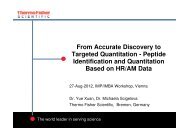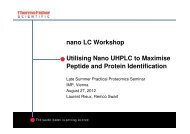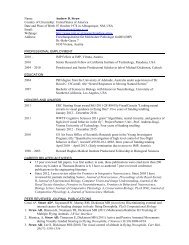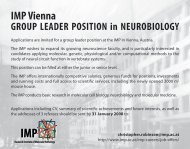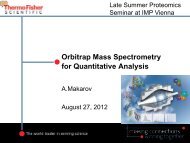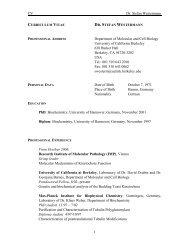IMP Research Report 2002
IMP Research Report 2002
IMP Research Report 2002
You also want an ePaper? Increase the reach of your titles
YUMPU automatically turns print PDFs into web optimized ePapers that Google loves.
Karl MECHTLER / Head of Facility<br />
Jan-Michael PETERS / Scientific Coordinator<br />
Mathias MADALINSKI / Technician<br />
Ines STEINMACHER / Technician<br />
PROTEIN CHEMISTRY FACILITY<br />
The <strong>IMP</strong> Protein Chemistry Facility performs a large variety of mass spectrometry<br />
experiments, including identification of proteins by peptide sequencing and<br />
characterization of post-translational modifications such as phosphorylation. In addition<br />
we develope new methods to increase sample throughput, sequence coverage and<br />
sensitivity in mass spectrometry. Finally, our facility specializes in peptide synthesis and antibody purification.<br />
Shotgun 2D Proteomics technology for the<br />
analysis of post-translational<br />
modifications in protein complexes<br />
Tandem mass spectrometry (MS/MS) experiments are<br />
capable of generating short stretches of sequence<br />
of MS/MS spectral data we identify the sites and types<br />
of modifications in large portions of the sequence of<br />
our protein complexes. By using proteases with different<br />
cleavage specificities we generate overlapping<br />
peptides. The analyses of overlapping peptides<br />
information but in most cases only a small fraction of<br />
all generated peptides can be recovered and analyzed.<br />
To overcome this problem we have developed the<br />
following “shotgun” approach. First, protein complexes<br />
are purified by immuno-precipitation and are subsequently<br />
digested by different enzymes: one that<br />
cleaves in a site-specific manner and one that cleaves<br />
non-specifically. Next, the mixture of peptides is<br />
separated by nano-HPLC or by the combination of<br />
multiple chromatography steps (“multi-dimensional<br />
liquid chromatography”) and is analyzed by tandem<br />
mass spectrometry. By combining the high sensitivity<br />
and the resolution of nanoscale multi-dimensional liquid<br />
chromatography with the precise structural specificity<br />
Figure: Shotgun Proteomics. Peptides were trapped on a SCX<br />
column normally at pH~3. At this pH value, the peptides are<br />
positively charged and the single charge is usually sufficient for the<br />
binding. Peptides were eluted from the SCX column with increasing<br />
ammonium acetate salt steps (from the top) onto the reversed<br />
phase column. Peptides obtained by this separation procedure were<br />
sequenced and analyzed using MS and the database search of<br />
generated MS-MS spectra.<br />
increase both the certainty with which modifications can<br />
be identified and the likelihood of obtaining peptides,<br />
from the “high-quality” MS/MS spectra can be obtained.<br />
This approach is particularly important for analyzing<br />
the complexity of multi-subunit protein complexes.<br />
Peptide synthesis and antibody<br />
purification<br />
We are synthesizing about 150 peptides per year,<br />
including an increasing number of branched peptides<br />
containing acetylated, phosphorylated or methylated<br />
amino acid residues. We employ a special protocol for<br />
affinity purification of antibodies under mild conditions.<br />
Contact: mechtler@imp.univie.ac.at<br />
Protein chemistry facility<br />
45




